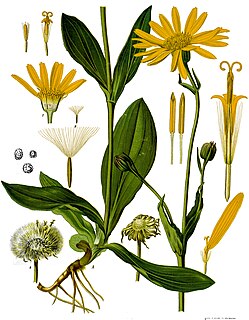
Arnica is a genus of perennial, herbaceous plants in the sunflower family (Asteraceae). The genus name Arnica may be derived from the Greek arni, "lamb", in reference to the plants' soft, hairy leaves. Arnica is also known by the names mountain tobacco and confusingly, leopard's bane and wolfsbane—two names that it shares with the entirely unrelated genus Aconitum.
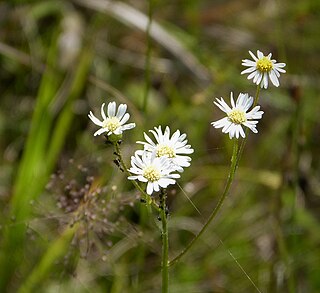
Boltonia diffusa, the smallhead doll's daisy, is a North American species of plants in the family Asteraceae. It native to the United States, primarily the states along the Gulf of Mexico from Texas to Florida plus the lower Mississippi Valley from Louisiana to Illinois. There additional populations in the eastern United States as far north as Virginia.

Heterotheca, are North American plants in the family Asteraceae.
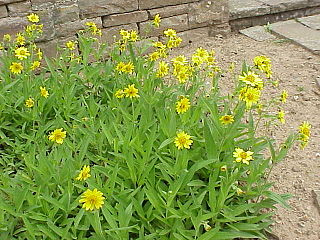
Arnica longifolia is a North American species of arnica in the sunflower family, known by the common names seep-spring arnica, longleaf arnica and spearleaf arnica. This flowering perennial is native to the forests of western Canada and the western United States.
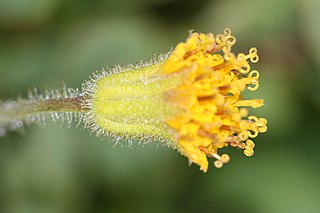
Arnica parryi is a North American species of flowering plant known by the common names Parry's arnica or nodding arnica. It is native to western Canada and the western United States as far south as Inyo County, California and McKinley County, New Mexico. It grows in temperate coniferous forests and alpine meadows in mountainous areas, primarily the Rocky Mountains, Cascades, and Sierra Nevada.
Arnica cernua is a species of arnica known by the common name serpentine arnica. It is native to the Klamath Mountains of northern California and southern Oregon, where it is a member of the serpentine soils flora.

Arnica cordifolia is a species of arnica in the sunflower family, known by the common name heartleaf arnica. It is native to western North America from Alaska to California to New Mexico, as far east as Ontario and Michigan. It is a plant of many habitat types, including coniferous forests, and moist mountain meadows from sea level to above 12,000 feet (3,700 m), but most commonly 4,000–11,000 feet (1,200–3,400 m).

Arnica discoidea is a North American species of arnica in the sunflower family. It is known by the common name rayless arnica because its flower heads have disc florets but none of the showier ray florets. It is native to the woodlands, forests, and chaparral of the western United States (Washington, Oregon, California, and western Nevada.

Arnica latifolia is a species of arnica in the sunflower family, known by the common names broadleaf arnica, broad leaved arnica, mountain arnica, and daffodil leopardbane. It is native to western North America from Alaska east to Northwest Territories and south to Mono County, California, and Taos County, New Mexico. It grows in mountain habitat such as forest and meadows.

Arnica mollis is a North American species of arnica in the sunflower family, known by the common name soft arnica, or hairy arnica. It is native to Canada and the United States (Alaska and the western mountains as far south as San Bernardino County, California and Rio Arriba County, New Mexico. There are also isolated populations in the White Mountains of Coos County, New Hampshire. The species grows in subalpine mountain habitat such as meadows and streambanks.

Arnica nevadensis is a North American species of arnica in the sunflower family, known by the common names Nevada arnica and Sierra arnica. It is native to the coniferous forests of the western United States, primarily the Cascades and Sierra Nevada.

Arnica sororia is a North American species of flowering plant known by the common name twin arnica. It is native to Western Canada and the Western United States. It grows in grasslands and in conifer forests, as well as the sagebrush steppe.
Arnica viscosa is an uncommon North American species of flowering plant in the family Asteraceae, known by the common name Mount Shasta arnica.
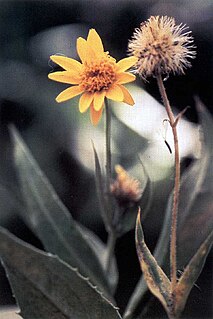
Arnica lanceolata is a North American species of flowering plant in the family Asteraceae, known by the common name clasping arnica or lanceleaf arnica. It has a disjunct (discontinuous) distribution in western North America and northeastern North America.

Arnica ovata is a North American species of flowering plant in the family Asteraceae, known by the common name sticky leaf arnica. It is native to western Canada, and the western United States.
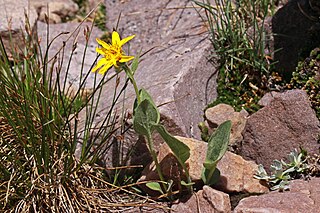
Arnica rydbergii is a North American species of flowering plant in the family Asteraceae, known by the common name Rydberg's arnica or subalpine arnica or subalpine leopardbane. It is native to western Canada, and the western United States.
Cirsium carolinianum is a North American species of plants in the tribe Cardueae within the family Asteraceae. Common name is Carolina thistle or purple thistle or soft thistle or smallhead thistle. The species is native to the central and southern United States, from eastern Texas east to Virginia and the Carolinas, north to the Ohio Valley.
Erigeron gracilis is a North American species of flowering plant in the family Asteraceae known by the common name quill fleabane.

Pyrrocoma liatriformis is a species of flowering plant in the family Asteraceae. Its common names include Palouse goldenweed and smallhead goldenweed. It is native to the northwestern United States, where it is endemic to the Palouse prairie, growing in grassland dominated by blue bunchgrass. It is a perennial herb growing from a taproot, producing one to three stems up to 70 centimeters in length. The stems are erect and hairy. Leaves near the base of the plant are larger and rounder than the leaves connected to the stem, which are lanceolate and hairy. Basal leaves measure 80–310 millimeters long and 9–30 millimeters wide, whereas cauline leaves measure 30–120 millimeters long and 5–20 millimeters wide. The inflorescence is four to five heads arranged in a raceme. Each head is composed of 17–25 yellow ray florets, each 6–14.5 millimeters in length, as well as 35–60 disc florets, each 7–11 millimeters in length.

Symphyotrichum jessicae is a species of flowering plant in the family Asteraceae endemic to Idaho and Washington states in the United States. Commonly known as Jessica's aster, it is a perennial, herbaceous plant that may reach 40 to 150 centimeters tall. Its flowers have violet ray florets and yellow disk florets. It is of conservation concern and known only from the Palouse River and Clearwater River drainages of eastern Washington and northwestern Idaho.















